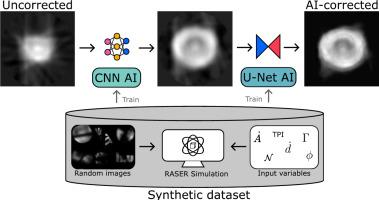Deep learning corrects artifacts in RASER MRI profiles
IF 2.1
4区 医学
Q2 RADIOLOGY, NUCLEAR MEDICINE & MEDICAL IMAGING
引用次数: 0
Abstract
A newly developed magnetic resonance imaging (MRI) approach is based on “Radiowave amplification by the stimulated emission of radiation” (RASER). RASER MRI potentially allows for higher resolution, is inherently background-free, and does not require radio-frequency excitation. However, RASER MRI can be “nearly unusable” as heavy distortions from nonlinear effects can occur. In this work, we show that deep learning (DL) reduces such artifacts in RASER images. We trained a two-step DL pipeline on purely synthetic data, which was generated based on a previously published, theoretical model for RASER MRI. A convolutional neural network was trained on 630′000 1D RASER projections, and a U-net on 2D random images. The DL pipeline generalizes well when applied from synthetic to experimental RASER MRI data.

深度学习可纠正 RASER 核磁共振成像剖面图中的伪影。
一种新开发的磁共振成像(MRI)方法是基于 "受激辐射发射的辐射波放大"(RASER)。RASER MRI 有可能实现更高的分辨率,本质上无背景,并且不需要射频激励。然而,RASER MRI 可能 "几乎无法使用",因为非线性效应会导致严重失真。在这项工作中,我们展示了深度学习(DL)能减少 RASER 图像中的此类伪像。我们对纯合成数据进行了两步 DL 管道训练,这些数据是根据之前发布的 RASER MRI 理论模型生成的。我们在 630,000 个一维 RASER 投影上训练了一个卷积神经网络,在二维随机图像上训练了一个 U 网络。当将合成的 RASER MRI 数据应用到实验数据时,DL 管道具有良好的通用性。
本文章由计算机程序翻译,如有差异,请以英文原文为准。
求助全文
约1分钟内获得全文
求助全文
来源期刊

Magnetic resonance imaging
医学-核医学
CiteScore
4.70
自引率
4.00%
发文量
194
审稿时长
83 days
期刊介绍:
Magnetic Resonance Imaging (MRI) is the first international multidisciplinary journal encompassing physical, life, and clinical science investigations as they relate to the development and use of magnetic resonance imaging. MRI is dedicated to both basic research, technological innovation and applications, providing a single forum for communication among radiologists, physicists, chemists, biochemists, biologists, engineers, internists, pathologists, physiologists, computer scientists, and mathematicians.
 求助内容:
求助内容: 应助结果提醒方式:
应助结果提醒方式:


